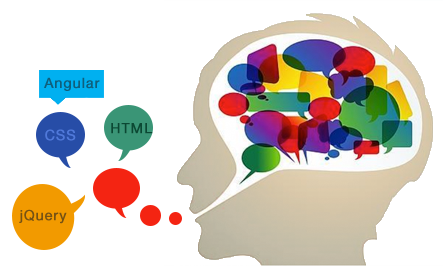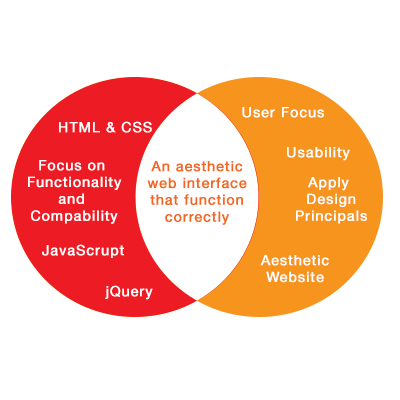 User Experience, Design thinking, Innovation, Customer Experience; these are a few terms floating in the IT field for the success of a product. Designers are considered to be crucial in the success of a product. A big responsibility is already on the shoulder of a designer. Should designer know or do coding along with designing?
User Experience, Design thinking, Innovation, Customer Experience; these are a few terms floating in the IT field for the success of a product. Designers are considered to be crucial in the success of a product. A big responsibility is already on the shoulder of a designer. Should designer know or do coding along with designing?
Does coding push the creativity back?
Coder mind push the creativity at back seat, like a designer cum coder will work with the limitations of implementation; or design that simplify the code efforts. This pushes the creativity back or makes it secondary.
Complexity of frontend and back-end development diverts the designer from solution to the achievement of implementation.
Let’s have a glimpse at the era of 2000
In 2000 around most of the designer was expected to design and convert the design to HTML code. Design and UI development was not disconnected because UI development was only HTML and CSS.
Design has expanded a lot today
User Research, Usability Analysis, Usability Testing, Aesthetic and Trendy Designs etc. are a few activities that has expanded the design field to a bigger platform. Design field has expanded from one designation to many different designations – like User Research Specialist, Usability Analyst, Visual Designer etc.
Similarly frontend technology has expanded
Frontend technology has grown with more sophisticated development methods. SASS and LESS has made CSS more robust. Grunt and Gulp has automated the frequently used tasks. jQuery for better animation and DOM manipulation.
Design and frontend development disconnected.
Framework like Angular and Backbone made the divider line thicker between designer and frontend developer.
Can overlapping of design and frontend development skill enhance the design?
Finding or making a skill perfect in design and perfect in development (includes MVC framework) is tough to maintain with the current trends. Because front end development is not only to get the expected design to materialize on the web.
It’s about performance, no matter, how great a design has been materialize on web. If performance is slow, it will cost losing of users, or I should say losing the business. Aesthetic design connects the user emotionally but first step is to get the user there.
Almost half of the web users expect a site to load in 2 seconds, if not, they abandon site. User will not even have a look at the design and move to some other site.
Frontend development is not only to materialize the design on web. It’s about giving a better user experience to user by enhancing the performance and a better interaction experience.

“Do not underestimate the power of a Front End Developer”
At what level, a designer can contribute in code?
If frontend development is about better user experience, better interaction, then why designer should not contribute in it. It will be really frustrated for the designer to giving PSDs to front end developer and disappointing with the result. It will be a time consuming activity to keep a task to and fro – review and rework.
Developer take the designer’s vision and bring it to a reality, what if, designer start a little contribution in the web conversion.
Responsive web designs heighten the complexity for designers with no code knowledge.
Responsive web design came in 2010 and product expanded from one device to multiple devices. Designer should understand the flow of the responsive web design and how a grid framework works.
A mixed of responsive and adaptive approach is in trend. Without understanding of the grid framework and adaptive approach, there will be a gap between deliverables of designer and front end developer, which leads conflict and poor design with substandard user experience.
Should designer know the CSS?
CSS enhance the browser capability and deals with the layout, composition, typography and animation. It’s more for the designer than developer. A designer can make a better use of it. By utilizing its capability, a designer can make a web page more interactive and aesthetics with better interaction.
jQuery made the designer tasks more easy
Animation and DOM manipulation is super easy with jQuery. Frontend technology started mixing with design in the year 2007-2010. It helps a lot in the quick high fidelity prototyping.
Disconnection between design and frontend development hamper the design quality and cause for the substandard user experience.
Conclusion
Design and frontend development both has expanded its wings. But a little overlapping of frontend skill along with design or design skill along with front end development can enhance the interaction and user experience.

HTML and CSS are the fundamental building block of a web page. It will be an extra feather on the crown of a designer to know HTML and CSS. A designer will get extra edge to get their vision into reality in a better way. Or at least knowing how things work on frontend and backend can make a better designer.
Making a perfect combination of designer and front end developer plays a vital role in the success of a product. It will be great if both have an overlapping skill set. A designer with front end knowledge and a front end developer with design understanding.
Or at least any one (Designer or Developer) should have the overlapping skill set.
Gopal, You should introduce yourself to to the history of innovations, Interestingly a “Coder” is ideal when he is using “design patterns” in implementing his code, but i wont be surprised if more identify them with limited vague thought of design itself expressed here.
In Software technology “design” is part of Engineering and engineering thought process, engineering practices and architecture shape the “code” too.
Continuing at every level of Software design process was a Full stack Developer, and Framework Definitions were then developed long ago for separation of concern, with increasing complexity. Now there is a bread and butter position of a Designer after so much of overhaul, but not long ago such positions existed.
“Design” does not just mean the look and feel, cognitive user engagement but also the components and their inter network delivering the meaning to the data in its product form. Trust me “innovation” cannot be driven from keeping anything at backseat. The components should be beautiful and be designed in apt form.
Trust me, if the Experts in cognitive user engagement, so called “designers” were bold enough to code from scratch, they will be sharing the load of product failures too.
– Honest personal opinion being a full stack developer.
Thanks Nilakhya, for your detailed and interesting comment. I am agreed with your point “Design does not just mean the look and feel”;
In a web project, it’s about logical and user friendly data representation that make sense for the user and reduce the cognitive load of the user. Look and feel is just one part of the design activity.
When a designer delivers the visual design, it’s not only a JPEG or PSD that is being delivered. A designer has to do lots of user research and brain-storming to get on that design. But yes, your point is valid “Design is a part of Engineering and engineering thought process”
Ultimately user is not just going to see the design; it has to be coded perfectly to make sense and “happy user”. Designer’s goal is achieved not only with a great design on paper but also its proper final materialization.